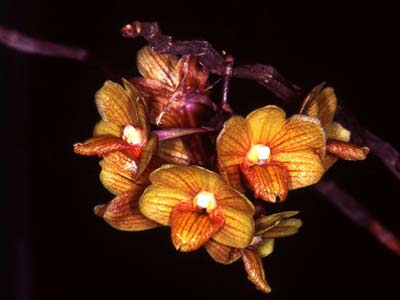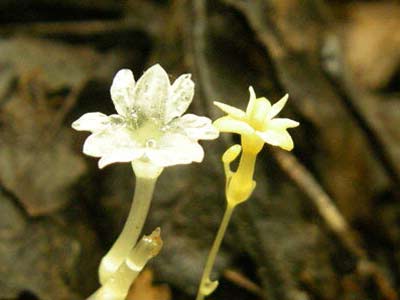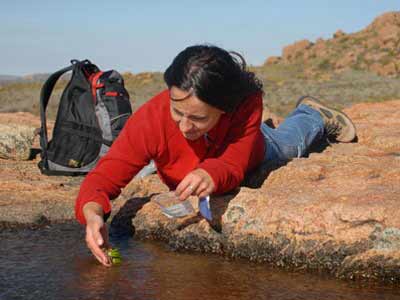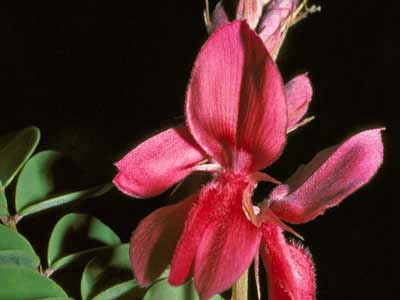Giant tropical rainforest plants, tiny fungi, and wild coffee are among the 300 species newly described by botanists in the UK in 2009.
 |
|
The newly discovered species include (from left to right) Berlinia korupensis, Lecomtedoxa plumosa, Carapichea lucida, Talbotiella velutina, Eucalyptus brandiana, and Cyrtostachys bakeri. |
These findings were recorded following an investigation by the Royal Botanic Gardens, Kew (RBG Kew) with a team of researchers from 100 countries around the world.
The new discoveries indicate that the known plant species represent only a small fraction of what exists. Among the newly discovered species, nearly one-third are at risk of extinction.
Stephen Hopper, Director of RBG Kew, stated that these new findings highlight the fact that many plant species in the world remain undiscovered and unrecorded. We will lack a scientific basis for effective plant conservation if we do not understand what exists in the plant kingdom and how it is evolving.
Kew’s botanists noted that 2009 was a bumper year with 292 newly discovered species, compared to an average of 200 species in other years.
Bursting Beans
 |
|
The tree has a diameter of nearly 1 meter, and when the large pod bursts, it disperses seeds over a wide area; the species Berlinia korupensis features large, beautiful white flowers. |
The largest of the newly discovered species grows in Korup National Park in the tropical rainforest of Cameroon, reaching over 42 meters in height.
Berlinia korupensis is a member of the legume family with a cylindrical trunk nearly 1 meter in diameter, producing large white flowers followed by fruit. The pods can be as long as 30 centimeters.
When ripe, the pods burst open, scattering seeds over a fairly wide area.
Xander van der Burgt, the lead researcher, indicated that only 17 trees were found during this investigation. He further remarked that even though Korup National Park is protected, Berlinia korupensis remains seriously threatened by human impacts.
The smallest species discovered is a type of wood-decaying fungus, measuring less than 1 millimeter and covering the host tree like a streak of paint.
Wild Coffee
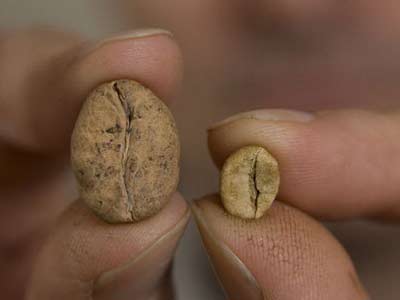 |
|
The world’s largest coffee beans from the wild coffee species Coffea ambongensis (left) compared to Arabica coffee beans (right). |
Seven species of wild coffee are also on the list of new species, most of which were discovered in the northern mountains of Madagascar.
Two of these new plant species, Coffea ambongensis and Coffea boinensis, produce beans larger than any other coffee species, with their beans being more than twice the size of common Arabica coffee beans.
Aaron Davis, a coffee specialist at RBG Kew, stated that coffee is the second most traded commodity after oil, with at least 25 million farming families relying on its products for their livelihoods. However, we still know very little about the wild relatives of coffee.
Dr. David estimates that nearly three-quarters of the world’s wild coffee species are threatened due to habitat loss and climate change.
Professor Hopper mentioned that approximately 2,000 species are newly recognized each year globally, emphasizing the need for adequate support and investment in plant research.
RBG Kew has just published information about the new species on its website and added details to Google Earth.
Below are images of some of the newly discovered plant species in 2009:
|
Dendrobium serena-alexianum is an orchid species found on the highest mountain in Borneo.
Gymnosiphon afro-orientalis is a flowering plant that does not photosynthesize and only parasitizes on host plants.
Dr. Rhian Smith collecting samples of the species Isoetes eludens at a stone lake in South Africa.
Isoetes eludens is an ancient aquatic plant over 150 million years old that has only now been discovered.
Indigofera serpenticola, one of the new species of indigo plants.
Botanist Linda Loffler examines Dioscorea strydomiana, a unique and unusual yam species she has encountered. This species is also at risk of extinction, with only about 200 individuals known in the wild. |








































